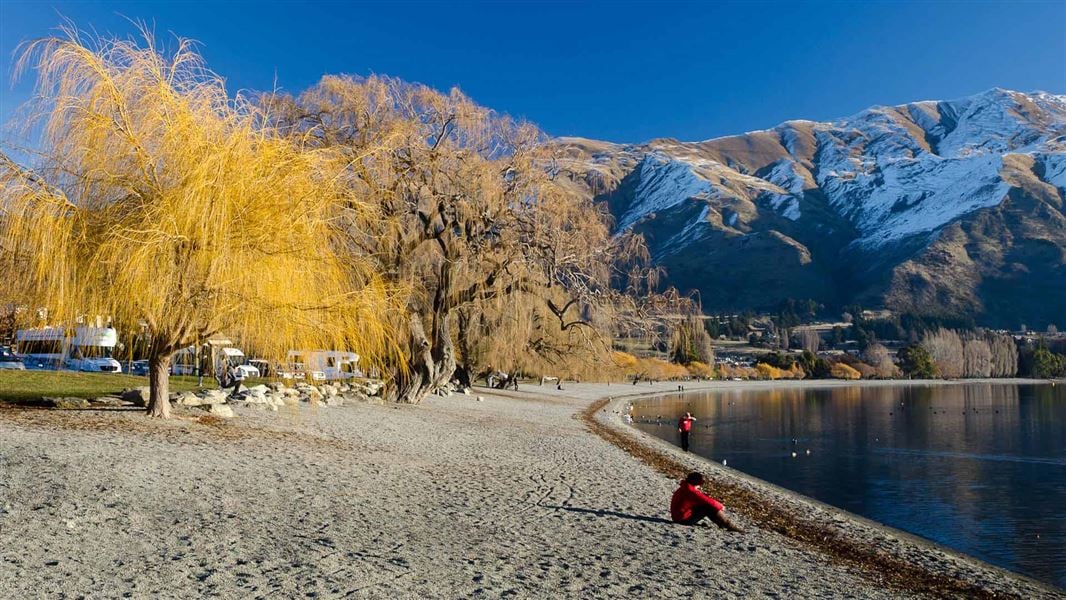Visit islands on Lake Wānaka: Mou Waho, Te Peka Karara, Mou Tapu or Ruby Island. You can walk or camp on Mou Waho and Te Peka Karara.
Your safety is your responsibility. All trampers need to plan properly and be well equipped. This includes having appropriate maps.
In summer, very hot and dry conditions are common. Make sure you carry an adequate water supply and, as this is a typical Central Otago climate, have adequate protection against the sun.
If venturing into the mountains, alpine conditions may be experienced at any time of year. Be prepared and ensure that you carry warm, windproof clothing and have the appropriate footwear. Naturally enough, the higher country is under snow during the winter months.
All drone use must be authorised by DOC
You must have a permit to fly a drone on public conservation land.
Visit our Drone use on conservation land page for more information.
Look out for bright red rātā flowers along the lakeshore over summer months, and between Rumbling and Minaret Burns, the forested slopes have a grove of mature kahikatea in a damp gully. This is one of only two records of this species in the lakes ecological region.
Other trees and shrubs in these substantial forest remnants include matai, Halls totara, olearia or tree daisy, mountain akeake, broadleaf/papauma, koromiko, kōwhai, rātā, kamahi, lancewood/horoeka, fuchsia and mountain ribbonwood. At higher altitudes regeneration is well under way with mountain and silver beech, kanuka, manuka and inaka (Dracophyllum).
Invertebrate life abounds, so too bird life. The New Zealand falcon/kārearea can be seen at higher levels. Lower down, among the regenerating bush, the forest species include fantail/pīwakawaka, bellbird/kōmako, parakeet/kākāriki and wood pigeon/kererū.
Beneath the surface, Station Creek is particularly important for its healthy population of the native galaxiid, koaro, one of the species that in its juvenile form is known as whitebait.
In pre-European times, Māori used parts of the eastern Wānaka region as staging posts for seasonal food gathering trips. Lakes Wānaka and Hawea were used by the people of the Lower Waitaki to collect eel, duck, weka and fern root. Umi ti – underground ovens to cook young cabbage tree roots – have been found at Colquhouns Flat. There’s little other evidence of these temporary settlements.
European pioneers immediately recognised the potential for farming, and the first runholder, H S Thompson, took up the Wānaka run in 1859. By the late 1880s, however, mismanagement and devastation by the introduced rabbit, saw him pack up and walk off the property.
West Wānaka Station now has 6450 ha of freehold land, though, as a pastoral lease it was much larger. In 1966 over 11,000 ha of mostly high altitude country was surrendered under a Soil and Water Conservation Plan. It is now the Mount Alta Conservation Area, lying within the Te Wāhipounamu -South West New Zealand World Heritage Area.
In 2005 West Wānaka Station completed the pastoral lease tenure review process. This brought a further 1000ha of conservation areas and reserves, allowing public access to areas of significant conservation and recreational value.
Wānaka Tititea/Mount Aspiring National Park
Visitor Centre
| Phone: | +64 3 443 7660 |
| Email: | wanakavc@doc.govt.nz |
| Address: | 1 Ballantyne Road Wānaka 9305 |
| Hours: | Visitor centre hours and services |
